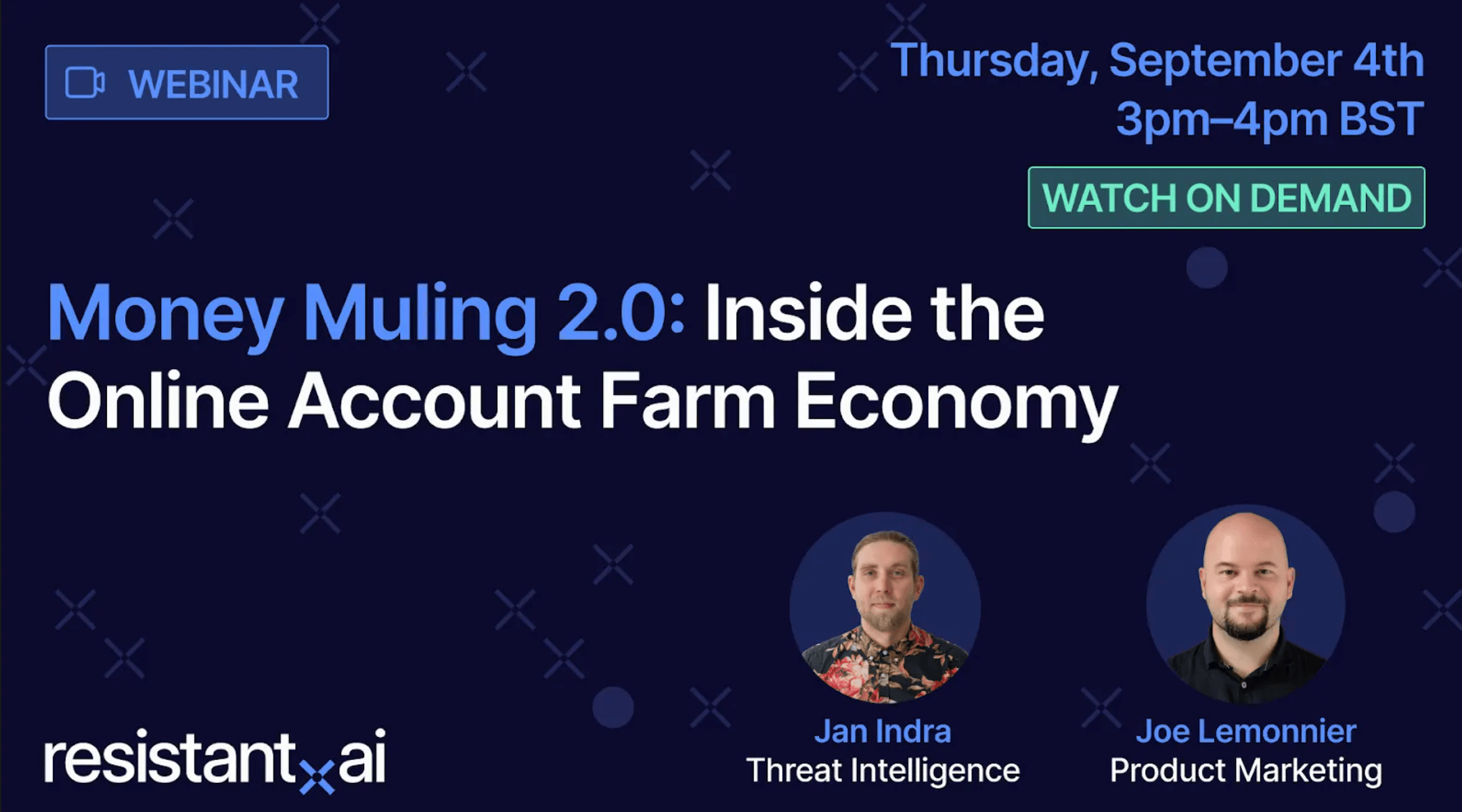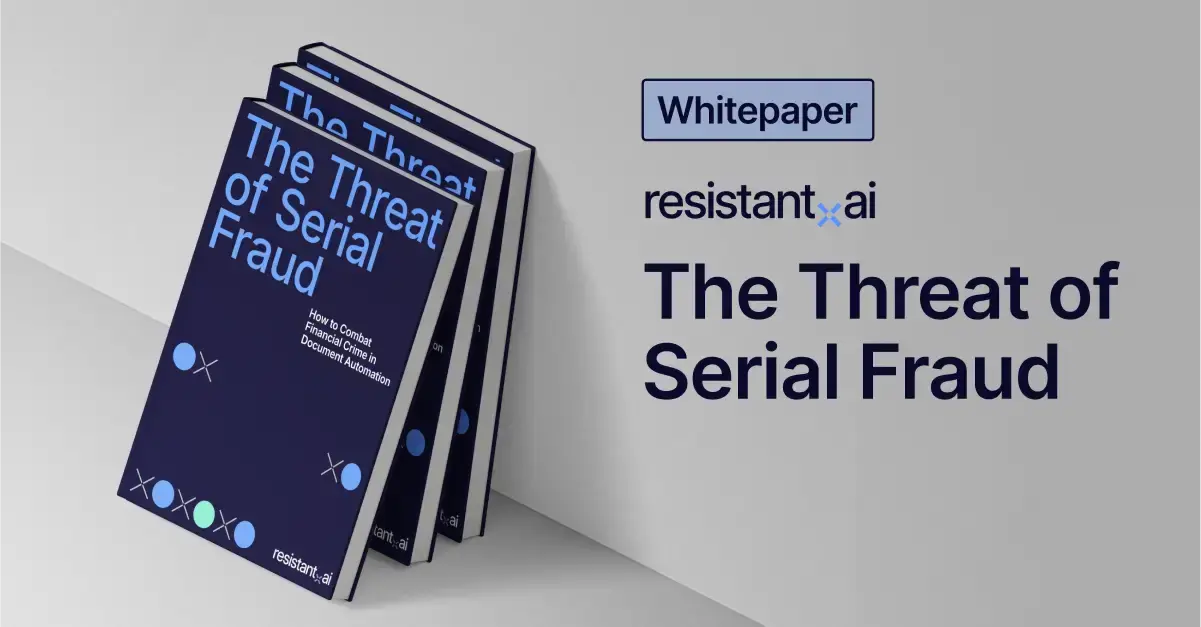KYB verification: Ultimate guide



Are you tired of justifying your know your business (KYB) verification decisions to your business unit?
Compliance and risk officers face a constant dilemma of evaluating the risk of deals with only themselves or their teams to back up the decisions. It can lead to a constant self-questioning cycle of concern, action, and doubt.
Was it really a fraud? Did I just kill a potentially business-changing deal? Does anyone really like me? If you’ve asked yourself these questions, you’re not alone.
You’re a part of the endless stream of compliance and risk professionals, product managers, legal and regulatory officers, analysts, consultants, investigative journalists, and even business owners/founders tasked with keeping fraudsters out of your business processes. And you’re doing God's work!
In this blog, we’d like to simplify the KYB process, providing a formal definition and clear indications of its necessity within your organization. We want to put your mind at ease, giving you confidence that you’re making well-founded decisions that help your company.
Read on to learn everything you need to know about KYB verification.
Table of contents
What is KYB verification?
KYB (Know Your Business) verification is the process of verifying the identity, ownership, and legitimacy of a business before entering into a financial or commercial relationship.
It helps companies prevent fraud, money laundering, money mules, and other financial crimes by ensuring they only work with trustworthy business entities.
KYB verification real world example:
To get a better idea of how KYB verification works in the real world, we’ve provided the following step-by-step which many companies follow:
-
Merchant registration. A B2B company signs up on a payment platform to process online transactions.
-
Document collection. Required documents are uploaded, including certificate of incorporation, proof of business address, bank account information, and shareholder structure. These documents are then verified and checked for different types of fraud.
-
Automated business lookup and UBO identification. The platform pulls official data from government registries to confirm the company’s legal status and incorporation details. The company submits details and ID documents for any Ultimate Beneficial Owners (UBOs) who hold 25% or more ownership.
-
Sanctions and watchlist screening. The business and its UBOs are screened against global sanctions lists, politically exposed persons (PEP) databases, and adverse media sources.
-
Risk scoring and AML assessment. The institution assigns a risk score based on factors like business type, jurisdiction, and ownership. High-risk entities may trigger enhanced due diligence.
-
Approval and activation. Once the KYB checks are successfully completed, the vendor account is approved and activated to begin processing payments.
-
Ongoing monitoring setup. Post-approval, the platform implements continuous monitoring for sanctions updates, corporate changes, and negative media coverage.
What processes require KYB verification?
Some of the processes that require KYB verification are:

-
Business account onboarding. Covers the initial verification of a business entity when opening accounts with banks, fintechs, crypto exchanges, payment platforms, or embedded finance providers. This includes merchant accounts, wallets, and API access.
-
Access to financial services. KYB is required when a business applies for loans, credit lines, BNPL, commercial insurance, or investment services. Essentially, any service involving financial risk or underwriting.
-
Supplier and vendor verification. Used in B2B marketplaces, procurement systems, and partner networks to ensure third-party businesses are legitimate and trustworthy.
-
Cross-border payments and trade finance. Required to validate international business partners and prevent sanctions breaches or trade-based money laundering.
-
Regulatory and high-risk use cases. Necessary for platforms operating in regulated sectors (e.g., finance, gambling) or handling sensitive data, identity, or large transactions where enhanced due diligence is critical.
These scenarios involve financial risk, regulatory obligations, or exposure to fraud. They prevent money laundering and terrorist financing. KYB ensures corporate transparency and stops them from doing business with sanctioned or blacklisted entities.
Why is KYB verification important?
Businesses are increasingly interacting in digital, cross-border, and high-risk environments. KYB verification plays a vital role in this tumultuous landscape, building trust, transparency, and compliance.
Just as KYC protects consumer platforms from bad actors, KYB protects B2B ecosystems from fraud, money laundering, and reputational damage.
It’s not just about regulation. These critical safeguards help platforms, banks, and fintechs understand who they’re doing business with and mitigate risk before problems occur.
Some of the benefits of KYB verification include:
-
Fraud prevention. Stop fake or shell companies from accessing financial systems or committing B2B fraud.
-
Regulatory compliance. Satisfy anti-money laundering (AML) and counter-terrorism financing (CTF) laws across jurisdictions.
-
Uncover hidden ownership risks. Many fraud schemes involve companies with opaque ownership structures. Identifying the Ultimate Beneficial Owners (UBOs) helps uncover who really controls a business — which is key to spotting front companies, proxies, or links to sanctioned individuals.
-
Sanctions and watchlist screening. Ensures you don’t engage with blacklisted or high-risk entities.
-
Trust and reputational protection. Protects your platform from undesirable associations like criminals and unethical actors.
What are the legal requirements of KYB verification?
KYB (Know Your Business) verification is a legal requirement in many countries across highly regulated industries, rooted in global efforts to combat money laundering, terrorist financing, and financial fraud.
It’s never been more important to become compliant. In 2023, U.S. regulators imposed a combined $9.2 billion in penalties on financial institutions, with the CFTC alone issuing a record $4.3 billion — its highest ever in a single year.
While KYC focuses on verifying individuals and KYB targets businesses, both are legal requirements in regulated industries. KYB obligations arise when service providers like financial institutions, real estate firms, or art dealers need to assess the money laundering risk of corporate clients.
The requirements typically involve verifying company registration details, addresses, and importantly, identifying the UBOs. These checks help prevent criminals from hiding behind complex corporate structures.
Regulations mandate due diligence based on the type of service and its associated risks. Financial thresholds often determine the depth of control, with enhanced checks required for higher-risk customers or transactions.
Many jurisdictions embed KYB requirements in anti-money laundering (AML) and counter-terrorism financing (CTF) laws:

-
USA. KYB obligations stem from the Customer Due Diligence (CDD) Rule issued by FinCEN (Financial Crimes Enforcement Network), which mandates that financial institutions collect and verify information about a legal entity’s beneficial owners.
-
EU. The 5th Anti-Money Laundering Directive (5AMLD) imposes similar requirements on banks, fintechs, and other regulated entities, demanding access to centralized UBO registries and due diligence processes.
-
UK. Post-Brexit, has retained similar standards through its own AML regulations governed by the Money Laundering and Terrorist Financing (Amendment) Regulations.
-
Globally. The Financial Action Task Force (FATF), an intergovernmental body, sets international AML standards. FATF emphasizes the importance of identifying legal persons and UBOs as a cornerstone of effective risk-based compliance.
In practice, failing to meet KYB obligations can result in regulatory penalties, loss of licenses, and reputational damage.
How to perform a KYB verification check: Step-by-step
KYB (Know Your Business) checks are a critical part of onboarding and monitoring business clients. They help verify a company's legal existence, ownership structure, and risk exposure.
Below is a universal guide to performing a KYB verification — fit for financial institutions, fintechs, marketplaces, and beyond.
1. Collect business identity information
Start by gathering all the basic registration and identity details that define the business.
-
Business name (including any trade names or DBAs)
-
Registered business address
-
Company registration number
-
Legal structure (LLC, Corporation, Partnership, etc.)
-
Country of incorporation
Request supporting documents like:
-
Proof of registered address (utility bills, lease agreements)
Once documents are collected, run them through a document verification process to check for signs of fraud.
Real world example: A European payment platform receives a merchant application from Lynovate Technologies Ltd., a company claiming to offer SaaS payment plugins.
The team collects standard business identity details, including a certificate of incorporation and proof of address — which turns out to be a co-working space in London.
While this meets the basic KYB requirements, the shared workspace raises a flag that will be reassessed in later steps. Also, the certificate of incorporation has a misaligned official seal which raises a red flag in your document fraud detection software.
2. Verify company registration and status
Once you’ve collected the documents, confirm the business is officially registered and actively operating.
-
Check against official registries. Verify that the business is properly registered and active in its jurisdiction by consulting government databases. Examples include:
-
Companies House (United Kingdom)
-
LEI Register (GLEIF) (Global Legal Entity Identifier Foundation)
-
SEC EDGAR database (United States)
-
ASIC Registers (Australian Securities and Investments Commission)
-
Registro Mercantil Central (Spain)
-
Infogreffe (France)
-
Handelsregister (Germany)
-
Orbis and OpenCorporates (for cross-border verification)
-
Confirm active status. Ensure it's not dissolved, struck off, or dormant.
-
Match official directors and UBOs. Listed in public databases.
Real world example: To verify registration, the onboarding team cross-checks Lynovate Technologies Ltd. against the UK’s Companies House.
The company is listed as active, with filings up to date, but the directors’ names and incorporation date don’t align with the company’s claimed five-year operating history.
This mismatch prompts a note for deeper UBO verification and signals possible misrepresentation.
3. Verify and screen ultimate beneficial owners (UBOs)
UBOs are individuals who ultimately own or control the business and must be screened to meet AML compliance requirements.
-
Collect:
-
Full name
-
Date of birth
-
Residential address
-
Valid government ID
-
-
Verify identity through KYC-level checks and ID verification.
-
Screen for sanctions, politically exposed person (PEP) status, and adverse media.
-
Analyze structure (if the company has unusual or hidden ownership distribution).
Keep in mind: Ownership percentages are easy to obscure. A sanctioned Russian oligarch may obviously own 50% of one company, but if that company owns only 80% of another, which owns 40% of the company you’re screening, the oligarch's involvement may be difficult to detect.
Real world example: During UBO verification, the team identifies two individuals listed as 100% shareholders of Lynovate Technologies Ltd. One of them, a 23-year-old recent graduate based offshore (outside the UK), has no visible connection to the payments or SaaS sector.
While not disqualifying, this raises further concerns about true ownership and control, triggering enhanced due diligence.
4. Screen the company itself against sanctions, watchlists, and adverse media
Now that you have an understanding of the company’s UBOs, you can run targeted screenings to identify known legal, regulatory, or reputational red flags of the company itself.
There may be some overlap between this and step three. UBOs are a huge part of KYB verification because if they own more than 50% of the company, the entity is essentially a reflection of their reputation.
Still, sanction screening, adverse media checks, and watchlists at the company level are vital inputs and should be done in addition to registry look-ups and UBO verification.
For example, in the UK, it’s estimated that 25% of companies registered with Companies House are fraudulent, highlighting the limitations of official registries in spotting fraud. To properly screen at the business level, perform the following:
-
Conduct sanctions screening. Screen the business and its against government-issued sanctions lists (e.g., OFAC, UN Consolidated List, EU Sanctions List, UK HM Treasury).
-
Conduct watchlist screening. Screen the business against additional lists to identify risk such as law enforcement lists (Interpol, FBI, etc.) and regulatory enforcement actions.
-
Run adverse media checks. Across global news outlets to uncover fraud, litigation, or misconduct by the company.
-
Re-screen regularly. As new watchlists and media events emerge.
-
Automate alerts. To catch status changes across the business or UBO network.
Real world example: Sanction checks for Lynovate Technologies Ltd. and its UBOs come back clean, but adverse media screening reveals that the company was previously partnered with a dissolved e-commerce firm flagged for chargeback fraud.
While no formal charges exist, this reputational risk reinforces the need for further verification before approving onboarding.
5. Review financial and operational legitimacy
Legitimacy checks help ensure the business is actually operating and not a shell or front for criminal activity.
-
Confirm digital presence (website, domain ownership).
-
Review business bank details and payment history (if accessible).
-
Check for trade references, vendor reviews, or client testimonials.
-
Analyze available financial statements or filings.
Any documents collected at this level (i.e., bank statements, invoices, earnings statements) should also be run through your document verification software.
Real world example: To assess legitimacy, the team reviews Lynovate Technologies Ltd.’s website, which is live but sparsely populated with templated content and no listed clients or case studies.
Attempts to verify the company’s business bank account and financials are unsuccessful due to missing documentation.
These gaps suggest the business may be newly formed or inactive. Without any documents to check for fraud, this further complicates the onboarding decision.
6. Conduct a business risk assessment
Before moving into screening, it’s essential to evaluate the overall risk profile of the business. Assigning a risk level (based on factors like business model, industry, jurisdiction, etc) determines how much due diligence is required and how often the business should be reviewed over time. You can extract a risk level by:
-
Official business information. If the company submitted all the initial KYB documents/info and they’re valid and verifiable.
-
Registration. If the company is registered with an official database and their details (i.e., registration number) match those officially submitted and publicly available.
-
Assessing ownership. Layered ownership, offshore entities, or nominee shareholders may increase risk.
-
Assessing the company itself. Checking adverse media, sanctions, and watchlist for warning signs and red flags.
-
Analyzing transactional behavior. Where relevant (volume, frequency, cross-border activity) and the validity of the documentation provided.
-
Using internal or third-party scoring models. Incorporates all the steps above to consistently score entities and track risk indicators.
Remember: Document the rationale for assigning a specific risk tier (low, medium, high) to maintain consistency.
Risk assessments guide how deeply you need to screen and monitor a business over time, if it should pass through your processes, or if it should be escalated for further evaluation.
Real world example: Based on the company’s offshore UBO, co-working address, and lack of verifiable operating history, Lynovate Technologies Ltd. is classified as high risk.
The team applies additional scrutiny given the payment sector’s exposure to laundering and shell entities. This risk score justifies deeper screening in the next phase of KYB.
7. KYB decisioning
After gathering and assessing all available data, the onboarding team must make a final decision: approve, escalate, or reject. This decision should weigh the full context: document authenticity, business legitimacy, UBO profiles, risk classification, and screening results.
Approvals may be conditional (e.g., pending additional documents), while high-risk or unverifiable entities should be escalated or declined in line with internal policy and regulatory thresholds.
Real world example: Given the:
-
Inconsistencies in company history
-
The use of a co-working address
-
The suspicious document profile
-
The unusual UBO structure
-
The adverse media link to chargeback fraud
The payment platform classifies Lynovate Technologies Ltd. as too risky to continue the process. Rather than outright rejection, the case is escalated to compliance for enhanced due diligence and a deeper investigation into ownership structure and business activity.
8. Document and audit KYB process
Every KYB check needs a strong paper trail for compliance and internal accountability.
-
Store all collected documents and data points.
-
Log all verification steps and decisions.
-
Maintain version-controlled records.
-
Respect data privacy laws (GDPR, CCPA) during storage and sharing.
Remember to conduct ongoing monitoring for all approved applicants to see if they fall out of line with requirements, are sanctioned, change their structure, etc.
Real world example: Following escalation, the onboarding team logs all supporting files for Lynovate Technologies Ltd. in their case management system — including identity documents, Companies House records, media screening outputs, and analyst notes.
The risk score and escalation rationale are clearly tagged, creating a complete audit trail for internal compliance and future reviews. This ensures that if regulators or auditors revisit the case, every decision is backed by verifiable documentation.
Keep in mind: KYB is not a "set and forget" task. It should be updated periodically based on risk appetite, transaction patterns, and regulatory requirements. Businesses dealing in high-risk regions or industries may need enhanced due diligence and more frequent refresh cycles.
KYB verification checklist
Now that you understand the steps of KYB verification, use this checklist on your next KYB verification to ensure you've performed all the necessary tasks.
-
Business identity information has been collected. Includes registration number, legal name, and date of incorporation.
-
Business has been verified with registries. Address, registration number, and other company information matches official records, corroborating with provided documents.
-
Document authenticity has been confirmed. Submitted documents have been checked for signs of forgery, tampering, or AI-generated fakes.
-
Application metadata has been reviewed. File creation dates, tools used, and edit histories align with expected submission behavior.
-
Ownership structure has been documented. Ultimate Beneficial Owners (UBOs) are identified and screened. Names and roles confirmed through registries and cross-referenced with sanctions databases.
-
Business has been screened. Business checked against watchlists, sanctions, and adverse media.
-
Business activity has been confirmed. Industry classification and stated operations align with known patterns or declared services. Document and activity details are valid and match the business name and jurisdiction.
-
Risk score assigned. You’ve used the information acquired in the previous steps to assign a level of risk to the organization.
-
KYB decision made. You’ve either approved the application, rejected it, or escalated it for further review.
-
Ongoing monitoring, documentation, and process review. Continuously monitor KYB-verified businesses, document decisions (and their reasoning), and review the process for improvements.
What documents are required for KYB verification?
When verifying a business under KYB (Know Your Business) regulations, companies are typically required to collect a set of official documents that confirm the entity’s legal status, ownership structure, and operational legitimacy.
Here are some of the most common documents required in KYB and what they verify:
-
Utility bill. Proof of address.
-
Bank statements. Bank account verification, proof of income, proof of address, counterparty screening.
-
Balance sheet. Proof of income.
-
Income statement. Proof of income.
-
Certificate of incorporation. Business verification.
-
Articles of association. Business verification.
-
Business license. Business verification.
-
Contracts. Proof of asset, proof of income.
-
Invoice. Proof of income.
How to automate KYB verification
Historically, KYB verification was a manual and time-consuming process. Compliance teams would collect company documents via email, cross-check business registrations on public databases, verify identities using PDFs and spreadsheets, and manually screen directors and beneficial owners against sanctions lists.
This approach is not only slow — it’s vulnerable. Human error, outdated records, and fraud can easily slip through the cracks. Manual KYB struggles to keep pace with the scale and complexity of modern B2B platforms, especially as more businesses operate across borders, in real-time, and under stricter regulatory oversight.
To address these inefficiencies, many companies have begun automating KYB workflows using rule-based systems. These systems follow pre-set logic to trigger key KYB checks and validations.
A typical rule-based KYB system might:
-
Query public business registries to extract business registration data in real time.
-
Instantly identify UBOs and verify their documents against pre-set requirements.
-
Run automated sanctions and watchlist screenings.
-
Assign a risk score based on defined factors like industry or jurisdiction.
Then, to orchestrate KYB more holistically, many companies adopt workflow automation platforms. These systems don’t just run checks — they manage the full onboarding flow.
They connect APIs from:
-
Government and commercial registries.
-
Identity and document verification services.
-
Sanctions and adverse media screening tools.
While these processes improve efficiency and reduce manual touchpoints, the decision-making logic in these tools still depends on rules or human-defined workflows. They’re not intelligent. They’re optimized.
Also, they’re still limited to pre-set, rigid logic. If data is incomplete, misformatted, or inconsistent, rule-based systems often fail or escalate the case to a human, slowing everything down and opening social engineering vulnerabilities.
That’s why the best companies are turning to AI-powered KYB verification solutions.
AI-Powered KYB Verification
AI-powered KYB doesn’t rely purely on rigid rules. These systems use machine learning to make smarter, faster decisions across messy and unstructured data.
AI can:
-
Parse documents in multiple formats and languages (even scans or screenshots).
-
Detect subtle anomalies in document structures.
-
Continuously monitor changes in corporate data and media mentions.
-
Prioritize high-risk cases with predictive risk models.
Unlike rule-based systems, AI can learn from new data and adapt to emerging fraud patterns without needing to be manually reprogrammed. It handles edge cases better, scales globally, and reduces false positives.
As a compliance team, you’ll be able to focus on real threats, spend less time chasing paperwork, and have a hyper-intelligent supercomputer to back up any decision you make.
Financial crime is evolving. With tools like ChatGPT, synthetic identity generators, and template farms, it’s easier than ever for bad actors to forge convincing business documents in seconds.
Volume is also a concern. If you’re a platform onboarding thousands of vendors or business clients each month, making manual or rule-based checks is impossible to sustain.
In this environment, AI is the only way to keep up with the criminals — and the competition.
Who must perform KYB verification?
Which institutions and business types mandate KYB verification? Here’s a comprehensive list:
-
Banks and traditional financial institutions. Must perform KYB to verify business loan applicants, open commercial accounts, and comply with AML/CTF regulations.
-
Fintechs and neobanks. Required to screen and verify business customers during onboarding, especially when offering banking-like services or issuing cards.
-
Payment processors and merchant service providers. Use KYB to ensure that merchants are legitimate businesses before enabling them to accept payments (e.g., Stripe, PayPal, Adyen).
-
Online marketplaces. Conduct KYB to validate suppliers and partners, avoid onboarding fraudulent entities, and maintain trust in multi-vendor ecosystems.
-
Lending and credit providers (including BNPL and invoice financing). Use KYB to assess the legitimacy and risk of business borrowers before extending credit or funding.
-
Insurance companies (commercial and cyber). Perform KYB to understand business clients, assess exposure, and prevent policy misuse or claims fraud.
-
Investment firms and wealth platforms. Required to verify business entities setting up investment accounts or funds, particularly under Know Your Customer rules adapted for business clients.
-
Embedded finance platforms and BaaS providers. Rely on KYB to vet third-party brands and partners offering financial services under their infrastructure, ensuring downstream compliance.
-
Cryptocurrency exchanges and virtual asset service providers (VASPs). Mandated under most global AML laws to verify business clients and prevent the misuse of crypto platforms for laundering or fraud.
Who needs KYB the most?
KYB is legally required, supervised, and enforced (with significant fines) for companies that facilitate financial flows between businesses, hold or move money, or enable high-risk or high-volume transactions.
It's the first place regulators look when you have fincrime happening in your institution. This makes it especially vital for:
-
Payment platforms onboarding thousands of merchants.
-
Fintechs embedding financial features into non-financial apps.
-
Crypto platforms exposed to fast-moving, global actors.
-
Marketplaces with large, dynamic vendor networks.
For these businesses, operating without KYB would be operationally and legally impossible. Without verifying who you're doing business with, you risk violating AML regulations in most jurisdictions, eroding trust, exposing your platform to reputational damage, and opening the door to billion-dollar compliance failures.
Challenges of KYB verification (and how to solve them)
KYB verification is critical, but performing it effectively comes with real-world challenges.
Compliance and risk teams tasked with balancing regulatory obligations, internal pressure to close deals quickly, and operational complexity must understand and navigate these challenges to be successful at their jobs.
Here are some the biggest challenges faced by KYB verifiers:
Tension with commercial teams
One of the most difficult dynamics for KYB verifiers is managing friction with sales and business units. When compliance flags a promising lead as high-risk or stalls onboarding for more documentation, it can feel like you're blocking revenue, not protecting the company.
You're left trying to justify risk-based decisions to people who may not understand regulatory obligations or risk factors.
Solution:
Build internal alignment with pre-agreed risk thresholds and escalation paths. When fraud is flagged, there should be no time for discussion.
You need a tool that can clearly explain and justify its findings. Educate commercial teams early about why compliance isn’t optional — it’s protection, not obstruction.
Dealing with uncertainty
Many KYB decisions fall into a gray area. You might spot red flags (like obscure ownership structures or implausible company activity) but lack definitive proof. The pressure to act (or not act) without certainty puts both the business and your reputation on the line.
Solution:
Use risk scoring models and tiered onboarding flows that let you assign "watch" status or trigger enhanced due diligence instead of making binary go/no-go decisions.
Fragmented and incomplete data
Company registries vary widely in structure and quality. You often get outdated filings, missing shareholder data, or contradictory info from different sources, making processes like UBO identification and verification incredibly difficult.
Solution:
Rely on multiple, federated data sources and document verification APIs to triangulate accuracy. Automate initial data normalization, but route inconsistencies to human review.
Jurisdictional complexity
Each country has different rules, risk levels, and disclosure standards. What’s transparent in the UK might be totally opaque in the UAE or BVI, which complicates global compliance policies and introduces blind spots.
Solution:
Maintain a jurisdictional risk matrix and tailor your KYB depth accordingly. Use tools that can customize verdicts based on your specific risk appetite. Deep local registry integrations and language coverage are must…
Unless you have a language and document agnostic solution.
Resource constraints
Most risk and compliance teams are under-resourced compared to the volume of onboarding requests they face. Manual document review, data entry, and sanctions checks pile up quickly, leading to burnout and backlog.
Solution:
Automate repetitive checks like registry lookups, document verification, and screening. Reserve human time for high-risk cases and contextual decisions.
False Positives and Alert Fatigue
Sanctions screenings and media checks often trigger irrelevant alerts — e.g., people with common names or companies with similar branding. Sorting through noise wastes valuable time and dulls your response to real threats.
Solution:
Use AI-powered screening tools with entity resolution, fuzzy matching, and context-aware filtering. Let AI prioritize alerts based on severity, not just keyword matches.
Pressure to Move Fast
The business wants instant onboarding. You need to slow things down to do them correctly. But you don’t want to become a bottleneck.
Solution:
Implement a tiered KYB approach: fast-track low-risk businesses while applying full due diligence to higher-risk profiles. Communicate turnaround times and risk-based workflows clearly. Implement tools that provide clear, actionable verdicts rather than nebulous risk percentages.
Dynamic business environments
Since businesses are constantly changing, reverifying them with KYB is important to do consistently. In addition, your business, risk profiles, and market/environment can change which may impact your requirements for those you onboard with KYB.
Solution:
Conduct ongoing monitoring of all approved applicants to track and register important changes. Also monitor your own processes for improvement and changing expectations/needs. In other words, there’s no such thing as a one-and-done review in KYB.
Unique KYB challenges and how Resistant AI fits in
After speaking to our head of product, Jan Syrinek, here are a few more challenges we’ve encountered while working in the KYB fraud detection space (and how our solution solves them):
-
AI-generated fraud on the rise. Scammers now use GenAI tools like ChatGPT to craft fake ownership histories and synthetic business documents.
Our AI detection models are specifically trained to catch this.
-
High operational overhead. Staffing, tooling, and training drain compliance budgets.
Our solution cuts costs while reducing headcount pressure without sacrificing accuracy.
-
Siloed and fragmented data. Disconnected systems prevent cross-checking and slow down fraud investigations.
Our serial fraud detection connects the dots across separate document submissions, while our “defense in depth” strategy connects multiple workflows.
-
Shortage of skilled KYB analysts. Talent gaps create risk blind spots and inconsistent assessments.
Resistant AI’s automation plugs that gap with trained, explainable decisioning.
-
Global document variety and scale. Global operations means dealing with a wide variety of documents, meaning very complex deployments and inconsistent outputs from different vendors.
Our AI tools normalize inputs and flag anomalies regardless of region or language.
KYB verification best practices
While every organization’s KYB process will vary by industry and risk appetite, these foundational best practices can help streamline operations, strengthen compliance, and reduce exposure to fraud.
Here are some best practices to keep in mind while building your KYB program:
-
Standardize your global framework with local risk adjustments. Establish a consistent KYB process across all markets, then adjust due diligence depth based on each jurisdiction’s transparency and risk level.
-
Build cross-functional alignment around compliance. KYB works best when sales, operations, and legal understand its purpose. Offer regular training and clear escalation paths so that compliance is seen as a business enabler and not a blocker.
-
Move from point-in-time checks to continuous monitoring. As your business changes, grows, and evolves, adopt tools that automatically track changes and trigger reviews post-onboarding.
-
Implement AI-powered document verification. Fraudsters are using AI to generate fake documents; your defense should be just as smart. AI tools can detect manipulation, inconsistency, and forgery at scale.
What’s new in KYB verification?
KYB verification has evolved rapidly in response to a world where digital-first business models, instant payments, and AI-generated fraud are the new normal.
In the past, verifying a business meant chasing paperwork, checking registries by hand, and relying on rigid, rules-based systems. Today, businesses are created and launched online in minutes, and payment platforms are onboarding thousands of merchants globally each month.
This speed has forced KYB to modernize: moving toward real-time verification, API-connected data sources, and AI-powered tools that can analyze documents, screen entities, and flag risk indicators at scale.
At the same time, tools like ChatGPT and generative AI have introduced a new threat: it’s now trivial to produce fake business websites, forged incorporation documents, and even synthetic ownership histories that can pass a basic check.
This has raised the bar for fraud detection and made traditional KYB systems (especially manual or rules-based ones) easy to deceive. Looking ahead, KYB programs must embrace machine learning, anomaly detection, and continuous monitoring to stay ahead of fast-moving threats.
The future of KYB will be less about static checklists and more about dynamic, intelligent risk assessment that adapts as fast as fraud does.
Conclusion
KYB verifiers must juggle cross-border data gaps, escalate fraud risks, justify tough decisions internally, and perform an endless amount of tasks that make the difference between safe, compliant institutions and walking risk time-bombs.
The process is as complex as it is critical. But the stakes are too high to rely on outdated tools and manual reviews. If you're tired of second-guessing decisions, defending slowdowns, or feeling like you're fighting fraud with a blindfold on — it’s time to modernize.
Scroll down and book a demo to see how Resistant AI’s intelligent, AI-powered KYB can transform compliance from a blocker into a competitive advantage.
Frequently asked questions (FAQ)
Hungry for more KYB verification content? Here are some of the most frequently asked question about KYB verification from around the web:
What’s the difference between KYC and KYB?
KYC (Know Your Customer) verifies the identity of individual users, while KYB (Know Your Business) verifies the legitimacy and ownership of business entities. Both are essential for compliance, but KYB focuses on companies and their beneficial owners, not just people.
How do KYC and KYB work together?
KYC focuses on verifying individual identities, while KYB focuses on verifying business entities. In many real-world scenarios, especially in B2B platforms, payment services, or fintech applications, both processes are required to ensure complete due diligence.
When a business signs up for your service, KYB ensures the company is legitimate. But that’s only half the picture — KYC is used to verify the Ultimate Beneficial Owners (UBOs) or company directors behind that business. For example, a payment platform might verify “Acme Corp” through KYB (checking incorporation documents, tax IDs, etc.), while simultaneously running KYC checks on the founder and CFO to screen for sanctions or identity fraud.
Together, they create a layered defense:
-
KYB = “Is this business real and trustworthy?”
-
KYC = “Are the people behind it who they say they are?”
Both are required under AML and CTF regulations in most jurisdictions, and both are essential to prevent shell companies, synthetic identities, or sanctioned individuals from slipping through.
What is enhanced due diligence (EDD) in KYB?
Enhanced Due Diligence (EDD) in KYB is a deeper level of business verification applied to high-risk entities during the onboarding process.
Unlike standard KYB checks, EDD involves collecting additional documentation, verifying complex ownership structures, and conducting thorough background screenings on both the business and its UBOs.
It’s typically required for businesses in high-risk industries (like crypto or gambling), those operating in high-risk jurisdictions, or when red flags arise during initial checks. EDD helps companies comply with AML laws and reduce exposure to fraud and regulatory penalties.
What is KYB approval?
KYB approval is the final step in the Know Your Business verification process, where a company is officially cleared to use a platform or service after passing all required checks.
It means the business’s identity, ownership, and risk profile have been reviewed and deemed trustworthy under applicable compliance standards.
How do you verify KYB documents?
KYB documents can be verified manually by reviewing business registrations, ownership records, supporting materials, and the document’s contents for signs of document fraud. Rules based approaches can automate this process with pre-determined requirements and expectations for applicants.
However, the most effective method is AI-powered document fraud detection, which can analyze unstructured files, detect forgeries, spot anomalies, and validate authenticity across multiple formats and languages far beyond the capabilities of manual or rules-based approaches.
What is required for KYB?
KYB (Know Your Business) typically requires official documentation to verify a company’s identity, ownership, and legal status. Common requirements include a certificate of incorporation, proof of business address, UBO identification, business licenses, and financial records such as bank statements or tax filings.
Get a full list of KYB documents in the “what documents are required for KYB” section above.
What is digital KYB verification?
Digital KYB verification is the process of verifying a business's identity, ownership, and legitimacy entirely online using electronic documents, databases, and real-time integrations. It replaces manual paperwork with API-based checks, digital document uploads, and automated risk assessments for faster, more scalable onboarding.
What is an automated KYB verification system?
An automated KYB verification system uses rule-based logic (or AI if fully modernized) to streamline business verification by connecting to company registries, validating documents, screening for sanctions, and assessing risk without manual input.
These systems reduce human error, speed up compliance workflows, and help businesses onboard clients more efficiently while staying compliant with AML regulations.







